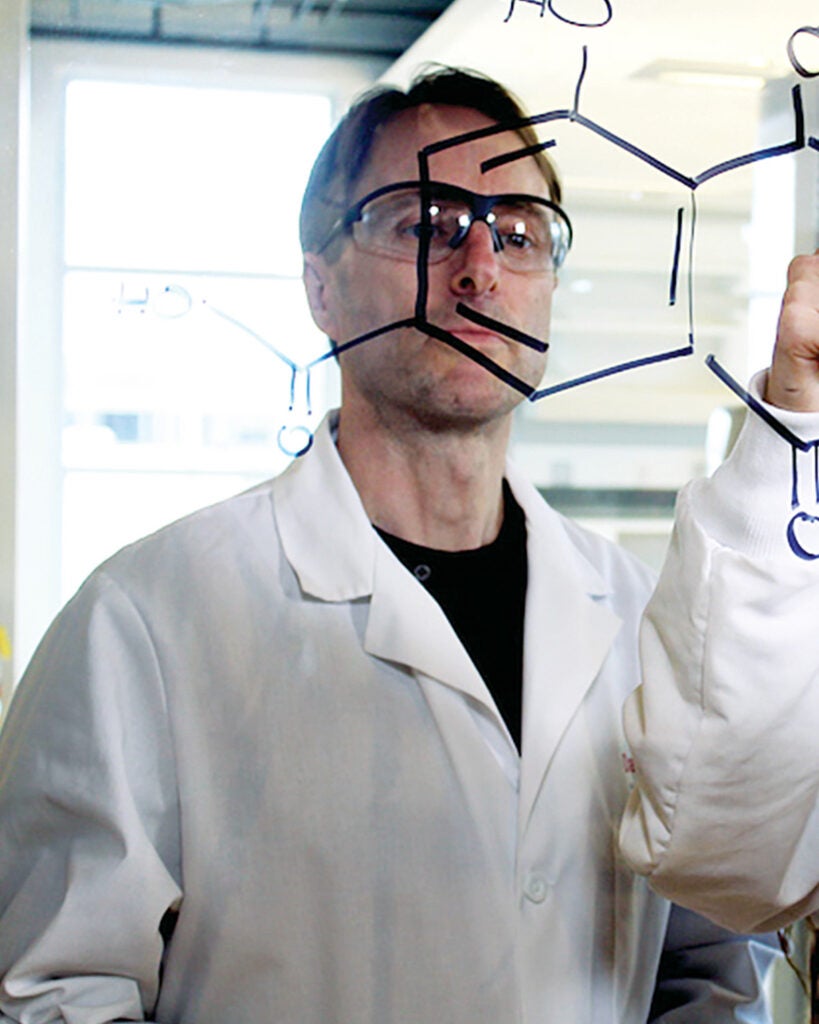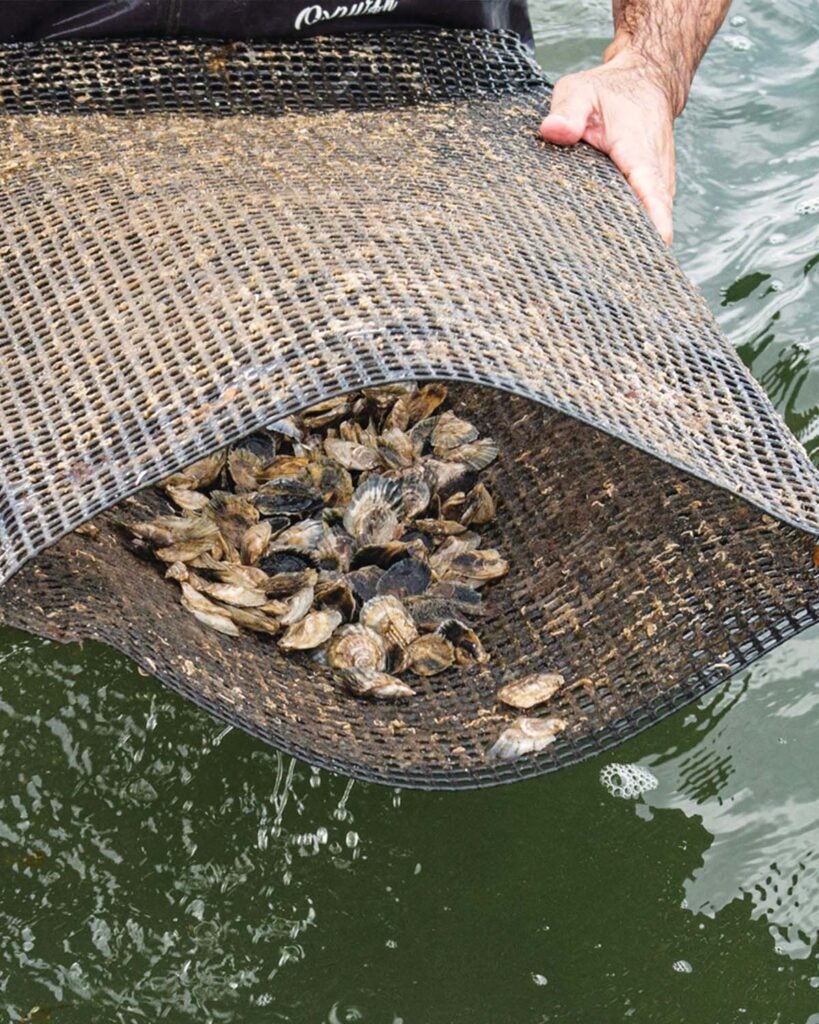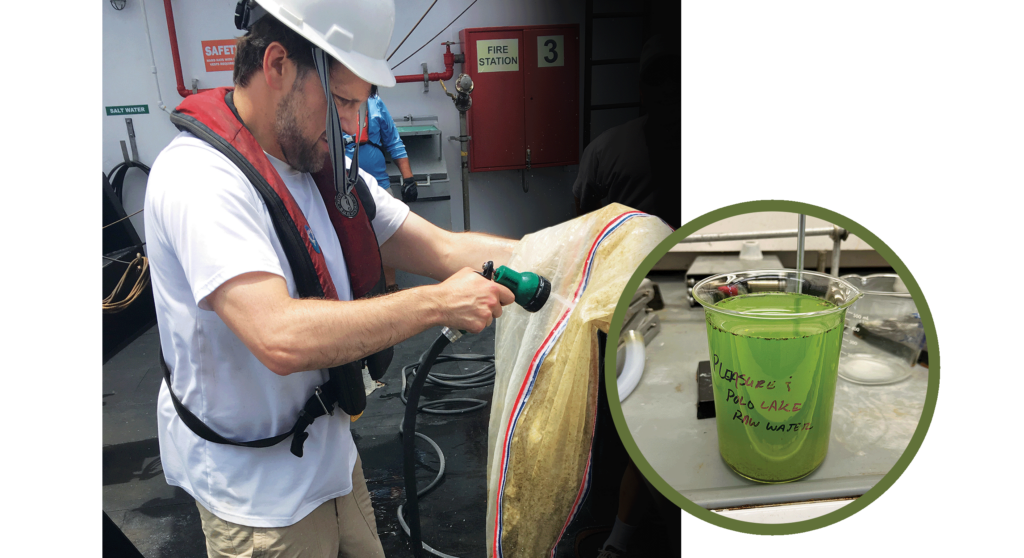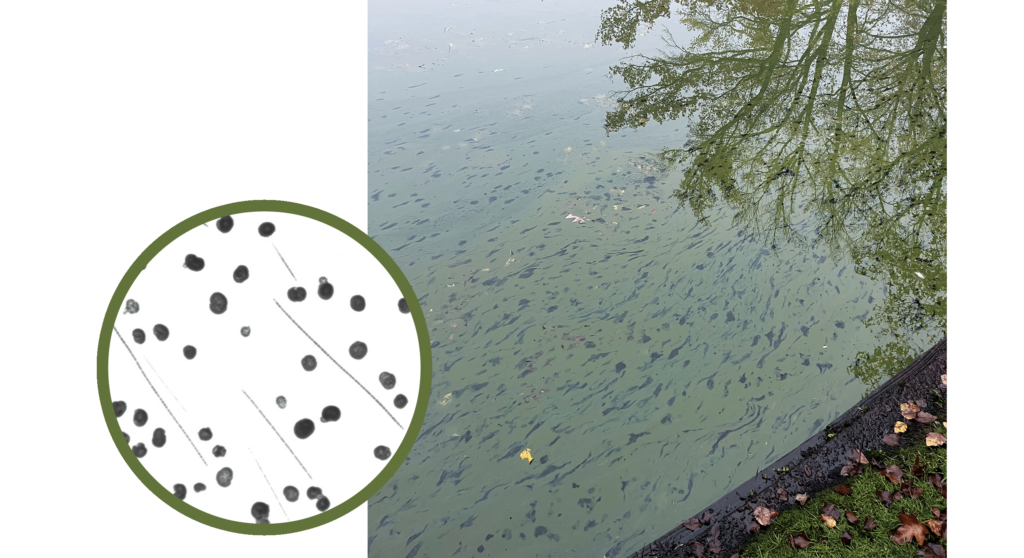Cyanobacteria on Pleasure Lake in Roger Williams Park. Matthew Bertin is investigating the chemicals in cyanobacteria blooms, which may hold a key to reducing neuroinflammation, a factor in diseases such as Alzheimer’s and Parkinson’s.
Two URI pharmacologists are continuing the URI College of Pharmacy’s tradition of marine research, expanding into freshwater systems—and wading right into the yucky stuff.
By Patrick Luce ’99
In the 1950s and 1960s, pharmaceutical developers began to look at the ocean as a new field for discovery, intriguing then-University of Rhode Island College of Pharmacy dean Heber Youngken. He soon recruited noted marine pharmaceutical researcher Yuzuru Shimizu to lead the college’s ocean research program and helped organize the first national “Drugs from the Sea” conference on URI’s Kingston Campus in 1967.
URI’s interest in marine pharmaceutical discovery has continued through the years and has expanded to include freshwater lakes and streams which, like bodies of saltwater, contain matter than can be both harmful and therapeutic, especially algae and bacteria. Pharmacy professors David Rowley and Matthew Bertin—both also oceanographers—are continuing the tradition, researching bacteria and algae. They are seeking new therapeutics as well as helping aquaculture systems avoid toxic disease.
“It’s not unique, but it’s uncommon” for oceanographers to populate colleges of pharmacy, Rowley says. “There is a long history at URI of marine pharmaceutical research spanning more than 50 years now. It’s about both identifying harmful elements in the water and extracting molecules that may have therapeutic possibilities.”
Both professors have made significant strides in developing new pharmaceutics and protecting aquaculture systems like shellfish farms, which are vital to the local and national seafood industry. They are working to identify contaminants like domoic acid—a human neurotoxin that can be absorbed by shellfish and, in turn, ingested by humans—often found in algal blooms, and to predict those blooms. Rowley and Bertin aim to create an ad-vance warning system for aquafarmers, so they know to harvest their crop ahead of a harmful bloom or to treat the shellfish with probiotic therapeutics, which the researchers are working to create.
Protecting Aquafarms
Rowley is particularly interested in how bacteria interact with one another. Using a chemical language known as quorum sensing, populations of bacteria coordinate their activities to be more successful, essentially acting as single multicellular organisms. Bacteria can work together to cause an infection, for example, or, conversely, they can act as a probiotic that protects other organisms. Research on bacteria behavior has the potential to positively impact shellfish farming, which is a staple of the blue economy locally and regionally.
“Aquaculture will be the way we produce seafood in the future, and one of the greatest impediments to aquaculture is disease.”David Rowley, Professor of Biomedical and Pharmaceutical Sciences
“We have pretty much exhausted the ability to harvest wild-caught shellfish and seafood,” Rowley says. “We have an expanding population of humans on the planet. If we’re going to meet future demands for seafood and protein production in general, we must overcome current limitations of agriculture and aquaculture. Aquaculture will be the way we produce seafood in the future, and one of the greatest impediments to aquaculture is disease.”
Rowley aims to protect shellfish farms from disease by isolating probiotic bacteria that can promote disease resistance. The microbiome of any organism is an important shield against infection. In humans, enhancing the gut microbiome by introducing probiotic bacteria can protect against more sinister pathogens, aid in digestion, and prevent disease. The same is true for marine creatures, including oysters like those found in the aquafarms that have become prevalent in Rhode Island and throughout New England. In addition to preventing disease, improving the microbiome of shellfish can improve the production of oyster seeds, leading to healthier, more prolific reproduction.


Algae blooms can produce a neurotoxin that is absorbed by oysters (right) and other shellfish. Research being conducted by David Rowley (above) and Matthew Bertin could help predict those blooms, allowing aquafarmers to harvest their crop ahead of a harmful bloom.
Rowley and his research team have discovered a probiotic bacterium that could protect shellfish farms from harmful pathogens. He is currently working with researchers in URI’s College of the Environment and Life Sciences and with biotech firm Kennebec River Biosciences to develop the bacteria into a commercial product.
“We’re trying to create a product that has beneficial effects—like kombucha, but for marine species,” Rowley says. “Hopefully, it will become a successful product that could benefit farmers and the entire shellfishing industry. That wouldn’t be possible without the ocean research we have engaged in over the years.”
Predicting Harmful Algal Blooms
In addition to preventing disease, the URI researchers are also working to forecast harmful algal blooms that can produce domoic acid, with the goal of keeping the human neurotoxin out of the food supply. Bertin has partnered with the National Oceanic and Atmospheric Administration (NOAA) on research in the Gulf of Mexico, where the blooms often thrive, as well as in Narragansett Bay. He is studying not only the harmful chemicals found in the algal outbreaks, but also the conditions in the water that cause them to bloom in the first place.
One way to predict the blooms, Bertin has found, is to monitor the levels of iron in the water. Iron travels across the Atlantic Ocean on winds from the Sahara Desert. The element, an important nutrient at normal levels, can lead to harmful algal blooms in the water when excessive concentrations are present.
“One of the biggest ways we can be helpful to the Rhode Island economy is by developing models for forecasting environmental toxins,” Bertin says. “If I raise mussels and oysters, and an algal bloom leads to my mussels testing positive for domoic acid, they cannot be used or sold commercially. If we provide better forecasting tools to give folks a heads-up that a bloom may be coming, or if we understand how to help the mussels or clams get rid of the toxin, that can be a cost-saver for the shellfishing industry.”
Creating Human Therapeutics
The research Rowley and Bertin are doing goes beyond protecting shellfish; it can have direct human benefits.
In one study, Bertin has teamed up with biotech firm Biosortia Microbiomics to study the chemicals produced by algal blooms, which may hold a key to reducing neuroinflammation, a significant factor in the progression of diseases such as Alzheimer’s and Parkinson’s.
Bertin and his team have isolated three chemicals known as micropeptins from Biosortia’s collection—which the company has harvested from natural events like algal blooms—that have shown as much as a 50 percent reduction in neuroinflammation in mouse cells, even in tiny doses. “We don’t actually know how they are working yet,” Bertin says of the micropeptins, which are chains of amino acids that play significant roles in vital biological activities. “Are they inhibiting something? Are they activating something? How are they reducing the inflammation?”
Cunliff Lake is one of three bodies of water in Providence’s Roger Williams Park that professor of pharmacy Matthew Bertin and his students have been monitoring for algae blooms. When blooms occur, Bertin’s team harvests and tests the algae for toxins.
Finding out is the next step. The team is using cell imaging and assays to visualize the effect the chemicals have. One possibility involves proteases, which are naturally occurring proteins in the body that break apart other proteins, often causing inflammation in a human cell. “If you can inhibit that protease by introducing small molecules like micropeptins,” says Bertin, “you can mitigate that inflammation process.”
Bertin’s team will next look at the effect the micropeptins have on human cells and seek a way to transport molecules into the brain to treat neurological disorders, a challenge because the molecules are often too large to easily slide through the body’s natural blood-brain barrier.
“We’re going to try to determine how they can be transported into the brain. There are tunnels in human cells that act like gates, letting certain molecules in,” Bertin says, noting he plans to further investigate a transportation mechanism during a separate study later this year, focusing on a different class of chemicals known as microcystins, produced by freshwater cyanobacterial blooms. “Brain cells have a barrier to keep unwanted molecules out, so getting them into the brain is generally difficult in pharmacology.”

Matthew Bertin (above) volunteered on a NOAA cruise to collect cyanobacteria. Here, he is spraying water to concentrate the cyanobacterial colonies in the codend of the net before processing and transferring them to preservation containers. Raw water collected from the lakes in Roger Williams Park (right). The green color is due to cyanobacteria in the water.
Monitoring Freshwater Resources
There are promising potential human benefits from chemicals in algal blooms, but more often the blooms are harmful to people, pets, and livestock, especially in freshwater lakes and rivers. Algal blooms often affect people by contaminating drinking water and placing a significant burden on local economies due to diminished recreational activity. The toxins can sicken pets and livestock that drink directly from the waterways and potentially pose a significant danger to people’s health.
Bertin is trying to mitigate the problem by developing a detection and monitoring system to protect the public, thanks to a $400,000 research grant from the National Institute of Environmental Health Sciences, a division of the National Institutes of Health.
Bertin and his team of three pharmacy students have been scouring lakes in Roger Williams Park in Providence—Pleasure Lake, Polo Lake, and Cunliff Lake—harvesting algae when it blooms on lake surfaces and testing it for toxins. The team partners with Biosortia, which has the capacity to access and harvest significant amounts of algae to study. Biosortia’s harvesting technologies enable researchers to evaluate aquatic microbial chemistry in its most natural state. The team has uncovered a surprising—and potentially alarming—number of new toxins in a short time.
“We’re trying to understand the full spectrum of toxins in these bloom events. Are we missing certain toxins that we need to be monitoring?”Matthew Bertin, Associate Professor of Biomedical and Pharmaceutical Sciences
“Just doing some cursory work, we found five new toxins. We think there are likely dozens,” Bertin says. “The Biosortia team led a study with help from my lab and found some extremely toxic molecules called cyanobufalins. They’re crazy toxic. One of the great challenges is that some highly potent toxins are difficult to access. Our lab, working with Biosortia, has found previously undetected elusive toxins. We really think there are many more. We’re trying to understand the full spectrum of toxins in these bloom events. Are we missing certain toxins that we need to be monitoring?”
Toxins abound in algal blooms; among the greatest dangers to people from such blooms is the effect the toxins can have on the liver. When the bacteria find their way into drinking water systems and are ingested, they can infiltrate the liver, causing damage, and even liver failure. The toxins can also cause skin ailments when people are exposed to the water and can even pose a threat if they make their way into dietary supplements, such as spirulina, which is made from blue-green algae. These threats heighten the need to know whether, and which, toxins are present.
Over the course of the two-year study, Bertin and his team have been collecting water from the lakes in Roger Williams Park once a week, or when conditions are right for an algal bloom, often in late summer and early fall, indicating that water temperature may play a role. They strain the water through various size filters to extract different organisms for study. As the team discovers new toxins, they are categorized so they can be monitored in waterways and alerts can be issued when those toxins are present in the water.
“Many organisms are in the algae. We are trying to isolate the many kinds of bacterial organisms and determine which organisms contain which toxins,” Bertin says.
Bertin’s team plans to discover and categorize the full community of toxic bacteria found in algal blooms and document the effects those toxins have on the human body.
“We want to know what the toxins are, how to detect them, and how to monitor them,” Bertin says. “We also want to know how these toxins work together. Do they all combine for a bigger dose? Do they act separately inside your body on different systems? We are trying to understand the full breadth of the impact these blooms might have on human health, especially as they become more common, due to how humans manipulate the land and water resources.”

Micrograph (left) showing single cells and filaments in the cyanobacteria from Pleasure Lake in Roger Williams Park. A severe cyanobacterial bloom on Pleasure Lake (right). The bloom covered the entire lake in a thick surface mat.
Looking to the Future
An increasing human population needing ever more water and food resources, combined with a warming climate that can exacerbate harmful events like algal blooms, makes research projects like Rowley’s and Bertin’s critical. Oceans and freshwater systems, Rowley says, are ripe for exploration that aims to find new molecules and produce new therapeutics, and we still need to learn more about how to predict harmful algal blooms.
“This research is important; it’s about making sure our communities are safe from harm, and our economies are not impacted adversely by things like algal blooms,” Rowley says. “Especially on a planet with a changing climate, we need to be more proactive in identifying the triggers that lead to algal blooms, and we need to be able to predict them.”
Photos: Patrick Luce; Nora Lewis; Courtesy Matthew Bertin
